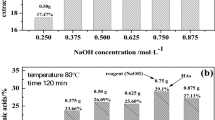Abstract
Oxidised lignite is a potential alternative source of N fertilizers. Ammonoxidation is the reaction of a given substrate with oxygen in aqueous ammonia. Lignite ammonoxidation is used for converting low-rank lignite into slowly nitrogen-releasing artificial humic matter. A lignite sample is compared before and after ammonoxidation in terms of geochemical and petrological properties, as well as the acid–base and physical hydrophobic sorptive behavior. The most obvious change caused by ammonoxidation is the decrease of attrinite, texto-ulminite and textinite in favor mainly of densinite and gelohuminite. In general, the ammonoxidative reactions promote the destruction of the structured humic macerals (texto-ulminite, textinite), and the formation of gels, which resulted in the cementation of the freely fine humic particles (attrinite). The pzc values are 3.4 and 4.3 for oxidised and non-oxidised lignite, respectively. After ammonoxidation the contents of carboxylic and free phenolic groups are found to be lower. The oxidised lignite shows a statistically lower sorptive capacity and affinity than the original sample due to a possible decrease in the hydrophobicity of the lignite.




Similar content being viewed by others
References
American Society for Testing and Materials (ASTM) D3174 (2004a) Standard method for ash in the analysis sample of coal and coke from coal. 2004 Annual book of ASTM standards, gaseous fuels; coal and coke, vol 05.06. ASTM, Philadelphia, PA, pp 322–326
American Society for Testing and Materials (ASTM) D5373 (2004b) Standard test methods for instrumental determination of carbon, hydrogen and nitrogen in laboratory samples of coal and coke. 2004 Annual book of ASTM standards, gaseous fuels; coal and coke, vol 05.06. ASTM, Philadelphia, PA, pp 504–507
Coca J, Aivarez R, Fuertes AB (1984) Production of a nitrogenous humic fertilizer by the oxidation-ammoniation of lignite. Ind Eng Chem Prod Res Dev 23:620–624
Flaig W, Salfeld JC (1960) Nachweis der Bildung von Hydroxy-p-benzochinon als Zwischenprodukt bei der Autoxydation von Hydrochinon in schwach alkalischer Lösung. Naturwissenschaften 47:516
Flaig W, Hingst G, Wesselhoeft P (1959) Verfahren zur Herstellung von stickstoffreichen Ligninprodukten. Deutsches Patent No. 1,745,632, 19 Jan 1959
Gierer J (1970) The reactions of lignin during pulping. A description and comparison of conventional pulping processes. Svensk Papperstidn 73:571–596
Gierer J, Imsgard F, Noren I (1977) Studies on the degradation of phenolic lignin units of the beta-aryl ether type with oxygen in alkaline media. Acta Chem Scand 31B:561–572
Gürüz K (1980) Oxy-ammoniation of Elbistan lignite to produce a nitrogenous fertilizer. Fuel 59:772–776
International Committee for Coal, Organic Petrology (ICCP) (2001) The new inertinite classification (ICCP System 1994). Fuel 80:459–471
International Committee for Coal Petrology (ICCP) (1971) International handbook of coal petrography, 1st suppl. to 2nd edn. Centre National de la Recherche Scientifique, Paris, France
International Committee for Coal Petrology (ICCP) (1993) International handbook of coal petrography, 3rd suppl. to 2nd edn. Centre National de la Recherche Scientifique, Paris, France
International Organization for Standardization (ISO) 7404-2 (1985) Methods for the petrographic analysis of bituminous coal and anthracite—part 2: method for preparing coal samples. ISO, Geneva, Switzerland
Kalaitzidis S, Karapanagioti HK, Christanis K, Bouzinos A, Iliopoulou E (2006) Evaluation of peat and lignite phenanthrene sorption properties in relation to coal petrographic features: the impact of inertinite. Int J Coal Geol 68:30–38
Kleineidam S, Schuth C, Grathwohl P (2002) Solubility-normalized combined adsorption-partitioning sorption isotherms for organic pollutants. Environ Sci Technol 36:4689–4697
Kratzl K, Schafer W, Claus P, Gratzl J, Schilling P (1967) Zur Oxydation von 14C-markierten Phenolen (Ligninmodellen) in wäßrig-alkalischer Lösung mit Sauerstoff. Monatsh Chem 98:891–904
Ninnemann H (2007) Strukturelle Merkmale N-modifizierter Braunkohlen unter besonderer Berücksichtigung der Huminstoffe. Dissertation, University of Dresden
Rentrop K-H, Teubel J, Rosenberger H, Schröter B (1984) Die Bedeutung der hochauflösenden 13C-NMR-Spektroskopie an Festkörpern für die Kohleanalytik. Freib Forsch A 704:25–54
Riera FA, Alvarez R, Coca J (1991a) Oxidation of hydrolyzed olive pits and almond shells with nitric acid in the production of humic-based fertilizers. Ind Eng Chem Res 30:267–270
Riera FA, Alvarez R, Coca J (1991b) Humic fertilizers by oxidative ammoniation of hydrolyzed corncob residues. Ind Eng Chem Res 30:636–639
Sýkorová I, Pickel W, Christanis K, Wolf M, Taylor GH, Flores D (2005) Classification of huminite—ICCP System 1994. Int J Coal Geol 62:85–106
Vakros J, Kordulis Ch, Lycourghiotis A (2002) Potentiometric mass titration: a quick scan for determining the point of zero charge. Chem Commun 1980–1981
Wender I (1976) Catalytic synthesis of chemicals from coal. Catal Rev 14:97–120
Yang C, Huang W, Xiao B, Yu Z, Peng PA, Fu J, Sheng G (2004) Intercorrelations among degree of geochemical alterations, physicochemical properties, and organic carbon equilibria of kerogen. Environ Sci Technol 38(16):4396–4408
Zakis GF, Neiberte BJ (1978) Formation of N-containing derivatives by simultaneous action of ammonia and oxidant on lignin. Khim Drev 1978(6):3–18
Acknowledgments
Konstantinos Dimou from the University of the Aegean, Greece, has provided technical assistance during the batch experiments for phenanthrene sorption. Dr Dimitra Kanelopoulou from the University of Patras, Greece, is acknowledged for support during the SSA determinations.
Author information
Authors and Affiliations
Corresponding author
Rights and permissions
About this article
Cite this article
Karapanagioti, H.K., Kalaitzidis, S., Vakros, J. et al. Effect of ammonoxidation on lignite properties. Environ Chem Lett 8, 373–380 (2010). https://doi.org/10.1007/s10311-009-0235-9
Received:
Accepted:
Published:
Issue Date:
DOI: https://doi.org/10.1007/s10311-009-0235-9




